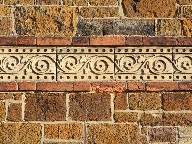| |
|
Union
Church, Hunstanton There is something delicious about
carstone at the best of times, that crisp gingerbread
stone carved out of the cliffs not far from here. The
tile and brick details on this pretty little church right
in the centre of the town add something extra, and make
this building wholly delightful. It was built as a
congregational church, and opened in 1870. The memorial
stone was laid by one of those ubiquitous Norfolk
congregationalists, the Colmans of Norwich. The forty
year old Jeremiah James Colman was reaching the height of
his power and influence by 1870. The following year he
became MP for Norwich, and was able to champion
non-conformism not only here in Norfolk but in the
corridors of power at Westminster.
| This
is, I think, an important building in the history
of Norfolk non-conformism. In layout, the church
is like a smaller version of the nearby Methodist
church, but that did not go up until a quarter of
a century later. The architect here was probably
the builder, a Mr Beeton. Given the early date,
the exquisite tiling on the walls is surprisingly
Art Nouveau in style, and the glass also appears
to be so, although I couldn't see inside to
confirm this: unlike Anglican and Catholic
churches, non-conformist churches have no
liturgical reason to be open outside of service
times. But this must surely be one of the
earliest examples of the Art Nouveau style in
Norfolk. I would have liked to have seen inside
for another reason: there is a curiously
ecclesiological apse at one end, and I wondered
if worship was actually carried out towards it.
This arrangement is common in non-conformist
churches of a couple of decades later, but it
would be an early example here. The
Hunstanton Congregationalists joined the new
United Reformed Church when it was formed in the
early 1970s, and then some time later a group of
local Baptists moved in with them, a not unusual
occurence. Today, they worship as the Union
Church, and I'm sure they're proud of their
lovely little building.
|
|
 |
|
|
|
